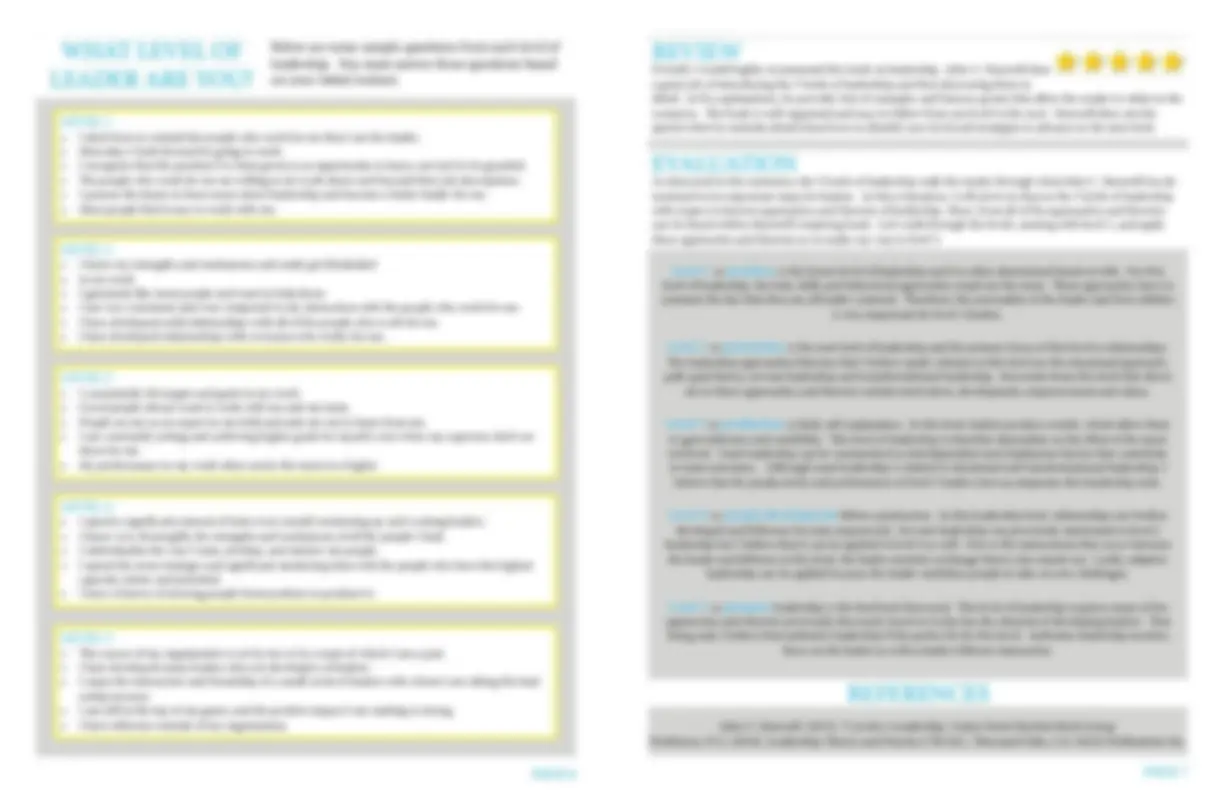




Study with the several resources on Docsity

Earn points by helping other students or get them with a premium plan


Prepare for your exams
Study with the several resources on Docsity

Earn points to download
Earn points by helping other students or get them with a premium plan
Community
Ask the community for help and clear up your study doubts
Discover the best universities in your country according to Docsity users
Free resources
Download our free guides on studying techniques, anxiety management strategies, and thesis advice from Docsity tutors
5 LEVELS OF LEADERSHIP. Proven steps to maximize your potential by John C. Maxwell. About the author. John C. Maxwell is a well-known.
Typology: Study Guides, Projects, Research
1 / 4

This page cannot be seen from the preview
Don't miss anything!



John C. Maxwell is a well-known American author that is recog- nized for a number of books on leadership. Maxwell was born into a Christian family and he followed in his father’s footsteps when he became a minister. Over the past 20 years, Maxwell has been a ded- icated speaker and author. He is also the founder of various lead- ership organizations where he focuses on helping others to be- come leaders around the world. Maxwell has reached millions of people with his workshops and books. He is passionate about devel- oping leaders that will develop others in order to live out his legacy.
In this book about leadership, John C. Maxwell provides read- ers with practical tools to achieve their leadership goals. Before discussing the 5 levels of leadership, Maxwell paints a clear picture of leadership and highlights that fact that it is a verb, not a noun. The main goals of the 5 levels of leadership include, breaking down leading into steps, developing a game plan for development and aligning practices, principles and values. Maxwell then walks the reader through the 5 levels of leadership and provides a description for each. As he describes each level, he elaborates to include specific upsides and downsides to each level, best behaviors to practice on that level and the laws of leadership at that same level. Before discussing the details of the next level, Maxwell describes the beliefs that will help a leader move to the next level. The hierarchy of the 5 levels can be sum- marized in the figure. Early on in the book, Maxwell establishes a link between leadership and influence.
Before discussing the details of each of the levels of leadership, Maxwell offers some general insight that help the reader understand how the levels relate to one another.
some of them are more obvious than others. For example, it is not surprising that as you move up a level, it becomes easier to lead but it requires more time and effort to get there. As an individual climbs up these lev- els, it also makes sense that you don’t lose the previous one. Some points that stood out might have been that you have to realize you are not on the same level with every person. Another point that is related is the fact that when you change positions it is unlikely that you will remain at the same level of leadership with the new organization. These two points really empha- size the value of relationships in leadership, which is discussed in many aspects throughout the book.
“Care without candor creates dysfunctional relationships. Candor without care creates distant relationships. But care balanced with candor creates developing relationships. …Caring values the person while candor values the person’s potential. …Caring establishes the relationship while candor expands the relationship. … Caring defines the relationship while candor directs the relationship.”
The first level of leadership mentioned is position. Maxwell mentions that most leaders start on this level and he references the fact that having positional leadership will provide you with a chance. It is then up to the individual what they do with that position that will determine whether or not they grow themselves or others and move up the hierarchy. One of the major upsides of position from the leadership perspective is that it is usually awarded based on identified potential. This should not however be confused with the fact that because you have a certain position you are automatically a leader. This level of leadership is associated with authority and recognition, however it also involves recognizing the limitations of the position. Because level 1 leaders are considered the lowest level that also means that these leaders have ample room to grow. This level of leadership puts emphasis on self-awareness. Maxwell mentions that leaders must know who they are, what their values are and what leader- ship practices they want to put into place in order to succeed.
“The leaders who do the greatest harm to an organization are the ones who think they have arrived. Once they receive the title or position they desire, they stop growing. They stop innovating. They stop improving. They rest on their entitlements and clog up everything. Make the most of this opportunity in leadership by making growth your goal.”
In order for leaders to move up to level 2, there are key beliefs that must be considered. This includes acknowledging that titles are not enough and that a leader’s most valuable asset is the people. While it might be attractive to “fake it until you make it”, leaders must know that it is acceptable to not know all the answers. Leadership requires collaboration.
The next level of leadership mentioned is permis- sion. In this level, Maxwell refers to influence and the importance of permission because it is focused on relationships. Having the right attitude is crucial for level 2 leaders. As the focus shifts from position to permission, there are various rewards that come along with level 2. J. Donald Walters stated, “Leadership is an opportunity to serve”. Servant leadership con- centrates on the growth and well being of people in order to grow the community. This leadership theory directly applies to level 2 leaders because it is the first level where the focus shifts from the leader to the follower. In order to put attention on relationships, leaders in this level must value and respect those around them. Maxwell provides an excellent example of placing value on people when he describes a story about Nelson Mandela. In brief, this story was about a successful businessman that had been invit- ed to Mandela’s home for a meet-
ing. The man arrived at his home and just before they started to eat Mandela asked if there was someone else that was joining them. Mandela was referring to the man’s driver, who he went out to the car to invite to join them for lunch. This story demonstrates Mande- la’s appreciation and value for all people, regardless of their role. Level 2 leaders must put a lot of effort into relationships, however this comes with it’s own chal- lenges. Permission leaders must be able to identify their people as takers vs. developers and acquaintanc- es vs. friends. For some people, this level of leadership is very difficult based on their personality. Maxwell encourages level 2 leaders to strike a balance between care and candor. He reminds the reader that permis- sion leaders do not need to treat members of their team like family. Families focus on community, while businesses focus on contributions. A great team will strive to have the best of these worlds.
In order for leaders to move up to level 3, there are key beliefs that must be considered. It is imperative that level 2 leaders know that relationships alone are not enough to move to level
REVIEW Overall, I would highly recommend this book on leadership. John C. Maxwell does a great job of introducing the 5 levels of leadership and then discussing them in detail. In his explanations, he provides lots of examples and famous quotes that allow the reader to relate to the scenarios. The book is well organized and easy to follow from one level to the next. Maxwell does not dis- apoint when he includes detail about how to identify your level and strategies to advance to the next level.
EVALUATION As discussed in this summary, the 5 levels of leadership walk the reader through what John C. Maxwell has de- termined to be important steps for leaders. In this evaluation, I will strive to discuss the 5 levels of leadership with respect to known approaches and theories of leadership. Most, if not all of the approaches and theories can be found within Maxwell’s inspiring book. Let’s walk through the levels, starting with level 1, and apply these approaches and theories as we make our way to level 5.
REFERENCES
John C. Maxwell. (2011). 5 Levels o Leadership. Center Street Hachett Book Group Northouse, P. G. (2016). Leadership: Theory and Practice (7th Ed.). Thousand Oaks, CA: SAGE Publications Inc.
level of leadership, the trait, skills and behavioral approaches stand out the most. These approaches have in common the fact that they are all leader-centered. Therefore, the personality of the leader and their abilities is very important for level 1 leaders.
The leadership approaches/theories that I believe speak volumes to this level are the situational approach, path-goal theory, servant leadership and transformational leadership. Keywords from this level that direct me to these approaches and theories include motivation, development, empowerment and values.
to gain influence and credibility. This level of leadership is therefore dependent on the effort of the team involved. Team leadership can be summarized as interdependent and emphasizes factors that contribute to team outcomes. Although team leadership is related to situational and transformational leadership, I believe that the productivity and performance of level 3 leaders best accompanies this leadership style.
developed and followers become empowered. Servant leadership was previously mentioned in level 2 leadership but I believe that it can be applied to level 4 as well. Due to the interactions that occur between the leader and follower at this level, the leader-member exchange theory also stands out. Lastly, adaptive leadership can be applied because the leader mobilizes people to take on new challenges.
approaches and theories previously discussed, however it also has the element of developing leaders. That being said, I believe that authentic leadership if the perfect fit for this level. Authentic leadership involves focus on the leader as well as leader-follower interaction.
WHAT LEVEL OF
LEADER ARE YOU?